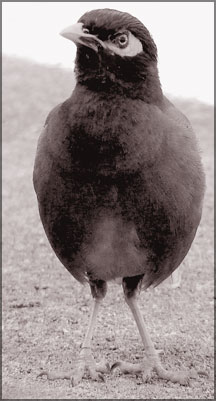What’s in a name?
Naming of birds in the orient region:
By Uditha Wijesena
[email protected]
Birds in the Orient were scientifically studied and classified by
British ornithologists. The British Empire having ruled over most of the
Orient became the authority in the Natural History of the region.
Though much of the taxonomical problems encountered in the scientific
naming have now been resolved by DNA analysis and other means, the
general names given to birds, are confusing even today.
|

Myna - a Hindustani name |
One such confusion is the naming of the Common Kingfisher. From a
layman’s point of view the term ‘common’ implies that it is found most
freely. It is the White Breasted Kingfisher and not the Common
Kingfisher which is the most ‘common’ kingfisher in the region. This
confusion had been discussed even in colonial Ceylon.
Legge’s “History of birds of Ceylon” shows that various authorities
had been responsible in the naming of these birds. Legge refers to the
Common Kingfisher as the Little Indian Kingfisher while he remarks that
Jerdon names it the Common Indian Kingfisher. He also goes on to say
that some call it the Little Blue Kingfisher.
In the description of the White Breasted Kingfisher, discussing its
distribution Legge states that, “It extends north of India to central
Asia and west ward to the Sinaitic peninsular, Nubia and Palestine.
To the east and south east of India to Burma, Mallacca, Andamans and
Nicoba, Java Sumatra Labuan, Borneo and Celebes extending northwards to
Formosa, Loochoo Islands , East China and Japan. Swinhoe received it
from Hakodadi, in northern Japan which is the most northerly observed
limit on the eastern bounds of Asia,” In no uncertain terms the most
common kingfisher in the region during the colonial era.
The present day distribution, as given in the Wikipedia Encyclopedia
states that ; White-throated Kingfisher, White-breasted Kingfisher or
Smyrna Kingfisher, Halcyon smyrnensis, is a tree kingfisher which is
widely distributed in south Asia from Turkey east to the Philippines.
This kingfisher is essentially resident over much of its range, apart
from seasonal movements.
Comparatively; the European Kingfisher or Common Kingfisher, Alcedo
atthis, is widely distributed in Europe, Africa, and Asia. It is
resident except in northern areas where the rivers freeze. It will then
move to milder regions. In most of its European range it is the only
kingfisher.
Probably, being the only kingfisher in the European range has made it
the Common Kingfisher the world over?
The Sri Lanka Blue Magpie, till recently was called the “Ceylonese
Jay” the Europeans in Ceylon called it the Blue Jay. This was then
legacy the Europeans left us. Orient Natural History from an European
perspective? On the other hand, birds that were found only in the Orient
were referred to by their native names; most of these names have now
been Anglicized.
The strangest of them is a bird being called a bull twice; the
Bulbul. This term and many others such as Munia, Koel, Myna, Besra,
Shikra, Kora (Water Cock), Baya are Hindustani names while the name
Pitta is of Telugu origin. The name Hoopoo is linked to the Hindustani
name Hudhud.
There is one family of birds in the Orient ‘Malkoha” whose name is
derived from Sinhala. Mal & Koha are two Singhalese words. We have two
birds in this family, the Blue Face Malkoha and the Red Face Malkoha.
However the Coucal has a phonetically similar name in Hindustani being
Mahoka.
In the mid 19th century birds that had not been recognised by the
natives were named after the Colonial ornithologists studying them.
These names were in use until Sibley and Monroe introduced a
universal taxonomy and nomenclature, towards the latter part of the
century.
Some of these names are in use, even in the Sibley and Monroe
classification.
There had been various concerns expressed on this change of names,
most of them being for nostalgic reasons. However when looking at the
animal kingdom as a whole in a scientific perspective, we need standard
nomenclature of birds the world over.
|
